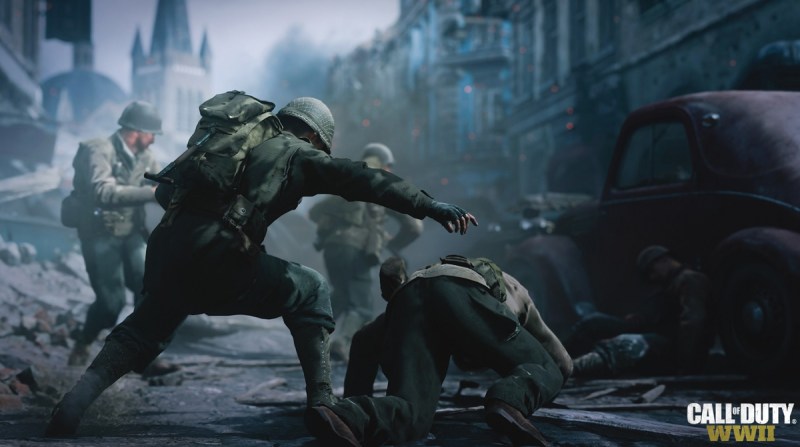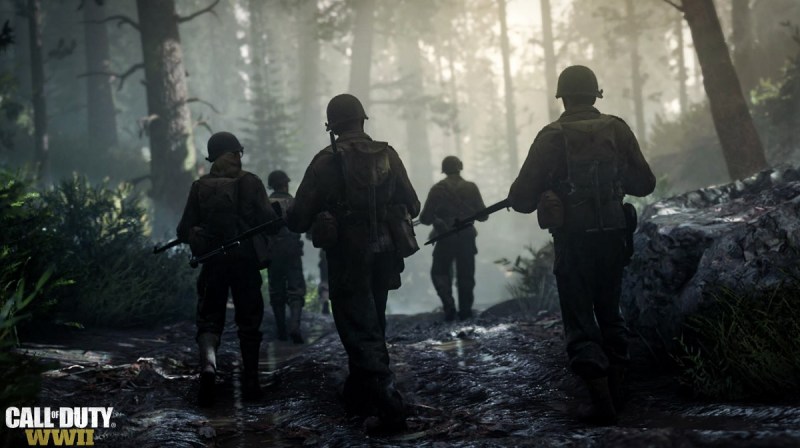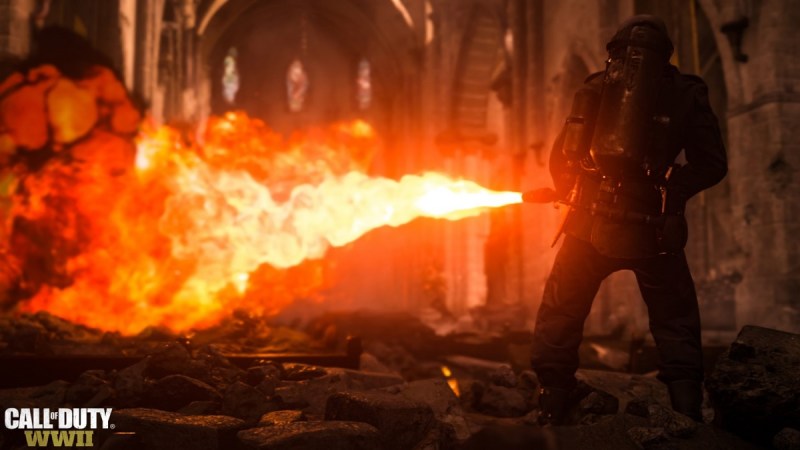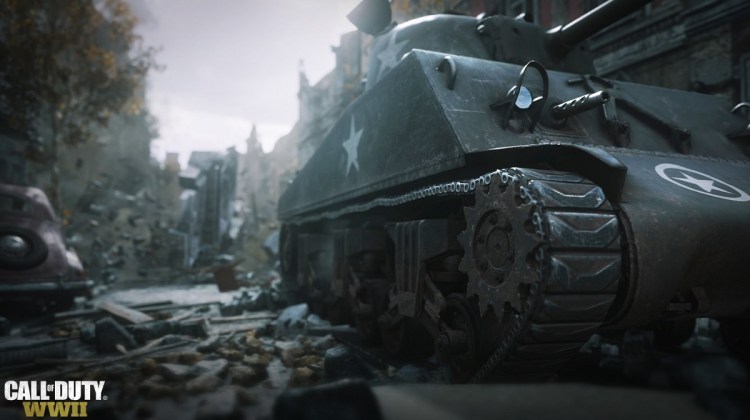Activision and Sledgehammer Games have revealed details of their next big game, Call of Duty: WWII.
Some information leaked on March 25, but the companies have now released a lot more, including the official trailer. GamesBeat was able to go behind the scenes at a preview event at Slegehammer Games in Foster City, California, and I interviewed key members of the team. And from what I’ve seen, it’s going to be an unflinching portrait of the combat experience of World War II, as witnessed by a fictional squad of soldiers in the fabled U.S. Army’s 1st Infantry Division.
WWII will follow the squad across Europe. It includes the horrific landing at Omaha Beach on D-Day in Normandy, Aachen, Hürtgen Forest, and the Battle of the Bulge. You’ll follow the story of Ronald “Red” Daniels, a young United States Army private, as he and his squad trek through the harrowing European theater of war. (Sledgehammer’s leaders will speak at our GamesBeat Summit event May 1-2).
June 5th: The AI Audit in NYC
Join us next week in NYC to engage with top executive leaders, delving into strategies for auditing AI models to ensure fairness, optimal performance, and ethical compliance across diverse organizations. Secure your attendance for this exclusive invite-only event.
With this game coming to PC, PlayStation 4, and Xbox One in November, Sledgehammer will take Call of Duty back to its roots, abandoning the science fiction and modern warfare that the franchise has pursued since 2008’s World at War. The point is to show the experience of World War II combat for a new generation (it’s been almost a decade since it took place in the conflict) and to approach it with a fresh look. This generation is growing up seeing fake news on social media and hearing about Holocaust denial.
“It’s an honor because the conflict itself is rooted in one of the most historic moments in human history when the common man came together to do uncommon things,” said Michael Condrey, a cofounder of Sledgehammer Games, at the preview event. “We get to honor and respect that global sacrifice. We started this journey wanting to tell this story because we wanted to remind the world so that we never let it happen again. The people who went to war, the veterans, are largely gone. We are telling it because the people who went are no longer here to tell it for themselves.”

Above: Sledgehammer Games cofounders Glen Schofield (left) and Michael Condrey.
Since World at War in 2008, more WWII veterans have died, and a new generation has grown up without being exposed to the horrors of that conflict.
The timing is good because the topic of World War II isn’t stale anymore. Technology and game narratives have also moved forward, which means the developers can return to the genre and do it justice. As I watched the hands-off videos of gameplay, the sound was vibrating and it felt in places like I was watching a movie, not a video game.
“You feel like you are really there,” said Glen Schofield, a cofounder of Sledgehammer Games, in an interview. “That was one of the important things, getting all the details right. To me, a game is a toy. What we’re creating is art. ‘Game’ doesn’t feel deep enough for what we make nowadays. They used to be more and more game-like. Now they’re story-driven, emotion-driven, all sorts of things. It’s an evolution of the art.”
It’s less a game, more like an experience, said Christopher Stone, animation lead, in an interview.
Condrey said, “What World War II offered us was to take you on the journey of the common man. What World War II offers us is it puts you right in the heart of these iconic battles.”
Both Activision and Sledgehammer wanted to return to World War II, and leave science fiction behind.

Above: The graphics have been taken up a notch in Call of Duty: WWII.
“It felt absolutely right,” Schofield said. “There’s never been a regret about not making Advanced Warfare 2 or anything like that. We felt like this was the right one to make. Creatively it was a nice challenge for us. We didn’t want to do rinse and repeat again.”
Condrey added, “We made this shift long before we knew anything about Dunkirk or any other interactive entertainment or linear entertainment was talking about WWII. We look at it now and it feels like the next 24 months is going to be a sort of resurgence for WWII in different entertainment spaces. We’re excited to be there. … We do listen to fans, obviously.”
One thing you’ll notice in the video is that Sledgehammer Games isn’t going purely for action. Nearly 300 people have been working on the game for 2.5 years at Sledgehammer’s headquarters in Foster City. They visited the battlefields in Europe, and they consulted with scholars like Marty Morgan.
“We’ve been all over the globe. We’ve been from Normandy to Gibraltar to Germany to Belgium,” Condrey said. “We’ve been across North America. We’ve sat in foxholes and Sherman tanks. We’ve driven half-tracks. You name it. We were in the Hürtgen forest at Hill 140.” (There’s an excellent movie about the forest battle, When Trumpets Fade).
David Swenson, audio director for Sledgehammer, also traveled the world in search of World War II-appropriate sounds, and he resorted to things like hitting tree branches with a sledgehammer to get the sound of trees being split by artillery shells.
Sledgehammer’s previous game, Call of Duty: Advanced Warfare, was more about supersoldiers and getting the player to feel powerful.
“This time around, the journey was more interesting,” said Joe Salud, the art director at Sledgehammer, in an interview with GamesBeat. “It wasn’t just about pretty pictures. It was more about evoking emotion, telling a story, getting the player to feel something. It’s about being emotionally relevant and impactful.”
The player will also join Allied forces from the U.K. and the French Resistance. I was able to see the scene at Omaha Beach, and then another patrol along a river in the Hürtgen Forest.
When you land at Omaha Beach in Normandy, your entire squad of soldiers gets shot going down the ramp. You have to jump over the side to avoid the same fate. That soldier, Red, has a moment of disorientation, where everything seems to move in slow motion. Then he dives for cover to avoid the machine gun fire.

Above: You are part of a squad in the 1st Infantry Division in Call of Duty: WWII.
The Call of Duty veterans among us have seen this seen before, in Steven Spielberg’s Saving Private Ryan in 1998, and Electronic Arts’ video game Medal of Honor in 1999. But what happens next is slightly different. Daniels’ commander tells him, “You can do this. This is what you trained for.”
He orders Daniels to pick up a Bangalore torpedo, like in scenes from The Longest Day and Saving Private Ryan. You have to pick it up and run up the beach, without a weapon. You put it under the barbed wire, pull the charge, and blow a hole in the line so the rest of the soldiers can charge through. What’s different about this particular scene is that the pressure is on Daniels to make sure that he doesn’t let his squad down. Whatever you think about this particular sequence, and whether you’ve seen it before, there’s no doubt that the scene has been tweaked to fit the theme.
“The main thing for me – and this speaks to all the cinematic moments we’re doing — we wanted to make sure you cared about the guys you were with,” said Bret Robbins, Sledgehammer’s senior creative director. “It’s not just being in an empty action sequence. There’s some kind of emotional connection to your squad. Some of the events that lead up to D-Day introduce your squad to you and give you a feel for them, so that maybe you’re a bit worried about them surviving alongside you.”
Like the film Platoon, Schofield said that the focus on the squad was deliberate, as it was a way to show the bonds of camaraderie, the brutality of war and the emotional attachment that you can develop for fellow squad mates.
“These guys were 17 years old, with eight weeks of training, and they were thrown into the war,” Schofield said. “They have to dig deeper in their lives, to the lessons they learned from their fathers, to know what to do.”
The scene shifts forward into the German bunkers above the beach, where the bullets ricochet off the walls and send echoes. The fighting is at close range, and it is brutal. One of your comrades gets hit, and you move to help. But a German soldier charges you and you both fall to the ground. You have to move quickly to grab and helmet and beat your foe to death with it. It’s a brutal — but not gratuitous — scene that shows how the development team isn’t pulling back from showing you something horrific up-close.
The scene in Hürtgen starts out with a conversation among the squad members. They split up into a different groups and head off to “Hill 493” to take out the German artillery. But as they move along a stream with amazingly realistic water sounds, they run into a German patrol. They ambush the patrol, and all hell breaks loose. The music picks up the pace, and the sounds of gunfire erupt.

Above: Flamethrower in Call of Duty: WWII
The gunplay is fast and realistic. You can take out some of the Germans, but more of them keep on coming. It’s a reminder that you are not a supersoldier. The Germans use their artillery to blow up the tops of trees, which send splinters raining down below. The only way to survive is to run for your life.
Activision will slowly reveal the storyline and more details, which includes single-player campaign, multiplayer, and cooperative play. Today’s news focuses on the single-player campaign and the game’s setting along with like the “war mode,” where teams battle for strategic objectives.
Multiplayer combat will follow the classic “boots on the ground” infantry battles. You can also develop your career as a soldier using a new Divisions feature. There’s a Headquarters hub where you can launch into various types of multiplayer. The game will have a co-op mode that has an original story and a “dark new enemy.” You’ll be able to play female characters in every part of the game, and play diverse ethnic characters, too. That’s significant, since many early Call of Duty games had no such option. But Condrey in particular cares about making games with diverse characters for diverse audiences.
“Our games are better when we have a diverse work force. They’re better when we have a diverse fan base,” Condrey said. “We want to give people heroes that they can look up to and be inspired by. It’s an important part of Sledgehammer’s value set. We spent a lot of time researching throughout the war, about all kinds of heroes. Men and women—women played many, many roles, from resistance fighters to the Wasps to people in the workforce at home. People of all races. We want to celebrate all the heroes in the allied cause.”
Call of Duty: WWII still has months of work before it’s done. But Sledgehammer’s crew was happy to reveal what they’ve been working on.
“This is the best game I’ve worked on,” Schofield said.
“Certainly it’s the most personal,” Condrey said.


